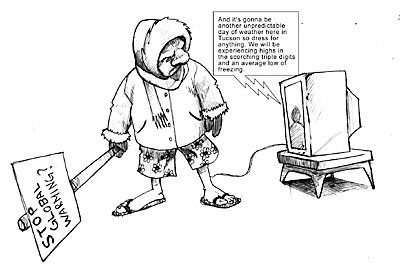
Illustration by Arnie Bermudez
|
|
By Jason Poreda
Arizona Daily Wildcat
Thursday, October 30, 2003
Ever since I started going to school here at the UA, I have had to deal with the incredible temperatures of the Arizona desert. We all endure the scorching heat of 100, 110, even 120 degrees where we literally bake ourselves walking around.
Finally it has cooled down, so to speak, to our comfortable 70- or 80-degree clear-sky weather as payment for putting up with these hellish conditions. That's of course why everyone loves Arizona: While the rest of the country is buckled down, bracing for the deep freeze, we get to sit by the pool drinking margaritas and getting a perfect tan.
Talking to people at the UA last week, however, you would have heard everyone complaining that it was "a little too warm for this time of year."
At the time, we were in the middle of a heat wave where we tied or broke several daily records with temperatures near 100 degrees. It's October, for crying out loud! Either Mother Nature has a sense of humor and is trying to torture us, or it must be global warming. What else could explain the broiling temperatures we had to put up with?
Here's a thought: We live in the middle of the freakin' desert!
While we were all pumping our fist at the sky in dismay, wondering why it wasn't a few degrees cooler and cursing global warming, everyone on the east coast was breaking out the winter coats and warm fuzzy hats.
When I came to Arizona I expected it be hot, very hot. I went out and bought all new shorts and Tevas, ready to embrace the new climate like I was going to the beach for the weekend. I, like many others who traveled from afar, was looking forward to it.
There must be a reason for this! It can't be that we live in one of the hottest places in the country; it must be something else. Global warming is finally taking over! If it's 100 degrees in October then the world must be coming to an end!
Eager to get to find an answer as to why we are all doomed to roast, I talked to Dr. Benjamin Herman of the atmospheric sciences department.
"Are heat waves uncommon here?" "No," He said bluntly, letting a smile creep onto his face upon hearing my question. Who could blame him? I could barely keep a straight face, and I was asking the question.
Dr. Herman agreed that it is unusual to have so many record-breaking days in such a short amount of time during any part of the year, summer or fall, but then added that, as in many parts of life, "records are meant to be broken. What was going on back in the 1900s when the records where set? Was it global warming then?"
Dr. Herman was skeptical about choosing a side on global warming, despite my best efforts, but it's safe to say he wasn't worried about the recent temperatures. I didn't see him packing his bags or anything; though, of course, if the climate were about to radically change, the only happy people would be the atmospheric scientists. Nonetheless, he does raise an interesting question for all of us.
If it was 96 degrees in Tucson on Oct. 21,1909, why not in 2003?
Perhaps this is a natural occurrence that's no cause for alarm. Natural heat waves tend to happen here and will probably happen again sometime soon, so stop breaking out the "stop global warming!" signs.
As Dr. Herman points out, global warming is an extremely complex issue and one that is debated by many scientists around the world. All that they have determined is that the issue is decidedly unsolved.
The truth is that our generation may never know if we humans have had the kind of detrimental effect on our climate that some think we have. Only time will answer that question. Until then however, we shouldn't cry "global warming!" from rooftops every time there is a heat wave, especially here in Arizona.
Instead, take comfort in the fact that when it's snowing everywhere else, the sun will be shining on your shades as you walk to class. Why is this? Because of something that should be burned into your brains: We live in the desert!
Jason Poreda is a political science and communication senior. He can be reached at letters@wildcat.arizona.edu.
